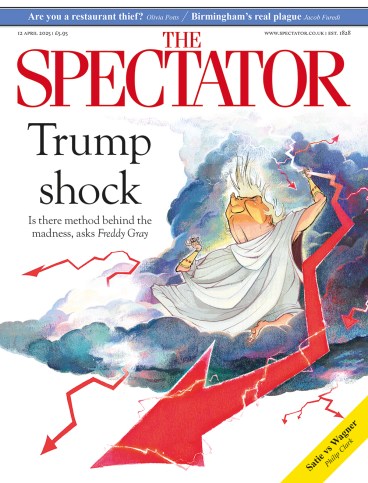
Tom Lee has narrated this article for you to listen to.
In the latest series of The White Lotus – a moral fable about the narcissism and toxicity of the privileged class – Parker Posey plays Victoria Ratliff, a Southern matriarch routinely spaced out on the tranquilliser lorazepam. Her daughter Piper asks why she needs it. ‘Certain social situations make me anxious,’ she drawls. When her husband Timothy (Jason Isaacs) gets word that his crooked financial empire is about to crumble, he starts necking Victoria’s pills in secret before swiping the bottle.
My ears always prick up at the mention of lorazepam because, like Timothy Ratliff, I have taken it illicitly to manage anxiety. However, I was not stealing it from my wife, but receiving it in the post from my mother.
This year is the 70th anniversary of the accidental discovery of Librium, the first of the benzodiazepine family of tranquillisers. Librium – quickly followed by close relations Valium, lorazepam and others – revolutionised the pharmacological treatment of anxiety and, between the late 1960s and early 1980s, Valium was the most widely prescribed pill in the western world: the defining drug of historian Arthur M. Schlesinger Jr’s so-called ‘age of anxiety’.
Benzos, and their predecessors, always had a bad image – not the countercultural glamour of weed, acid, cocaine and heroin, but the go-to drug for the desperate suburban housewife in the Stones’ ‘Mother’s Little Helper’, or the ruined starlets of Jacqueline Susann’s Valley of the Dolls and Joan Didion’s Play It As It Lays.
Benzos’ image problem was soon accompanied by a broader panic about the medical dangers of the drugs. This went mainstream in the UK in 1984 via an item on Esther Rantzen’s That’s Life: an outpouring of stories from viewers who described a host of life-wrecking symptoms they believed had been caused by the drugs or by trying to come off them. Prescribing guidelines were tightened, with warnings that treatment should be limited to short periods, and long-term users advised to come off them gradually. A class action lawsuit involving 17,000 people followed in 1988 – the then largest ever in the UK.
In 2007, with no previous experience of mental illness, I suffered a sudden descent into acute anxiety which left me unable to work, parent or even leave the house. The Prozac-type antidepressants I was given had no effect and, seeing how much I was suffering, my mother suggested I take one of her lorazepams – the only psychiatric drug she felt she had ever benefited from over a long period of mental ill-health. The effect was miraculous: more or less immediate relief from my anxiety and the chance to function again. My GP, and everything I read online, warned in drastic terms about the risks of addiction and withdrawal, but my mother continued sending me a small strip of pills once a month and I used these to stay afloat and start putting my life back together.
As The White Lotus goes on, Timothy, increasingly bombed on lorazepam, staggers zombie-like around the luxury hotel. At one point he inadvertently exposes himself to his children by allowing his dressing gown to flop open; at other times he fantasises about killing them and himself. Meanwhile, Victoria frets over her missing pills and Piper quips: ‘You don’t have enough lorazepam to get through one week at a wellness spa?’
The effect was miraculous: more or less immediate relief from my anxiety and the chance to function again
This representation of lorazepam – and benzos in general – has barely changed since the 1960s: the lifestyle drug of the moneyed class, numbing themselves to the hollowness of their affluence and risking an overdose in the process. ‘Mother’s Little Helper’ never went away.
What’s obscured by this – and by the continuing clinical and social panic around the drugs – is the profound benefit they can have for people like me who have suffered from acute anxiety. Prescribing guidelines in the US, where the patient is more like a customer to be accommodated, are far looser than in the UK, and Victoria Ratliff’s easy access to lorazepam is plausible. In the UK, it’s a different story. My GP refused to prescribe it to me and warned in apocalyptic terms about its risks. GPs vary – my mother’s is a case in point – but my own experience appears close to the norm: an extreme reluctance to prescribe even a short course, and a deep concern about its addictiveness. One GP I spoke to said he would only consider a benzodiazepines prescription at the point where a patient suffering a mental health crisis was waiting to be hospitalised.

Many academics and clinicians believe the reputation of benzodiazepines is in need of reappraisal. Clare Stanford, Professor Emerita of neuropharmacology at University College London, tells me: ‘The image of [them] as a terribly dangerous drug is completely inaccurate.’ Stanford acted as an expert in the 1980s class action suit and concluded that at the recommended dose and duration, there was no evidence the drugs would lead to addiction. She noted that the class action collapsed before reaching trial.
The authors of a 2020 article in the British Journal of Psychiatry entitled ‘Benzodiazepines: it’s time to return to the evidence’ make the same case, arguing that when appropriately prescribed for anxiety, they are ‘not widely abused drugs’; nor are they ‘gateway drugs leading to other abuse’.
Andrew Solomon, author of the landmark 2001 book The Noonday Demon: An Anatomy of Depression, goes further, maintaining that the fear of addiction has led to ‘gross underuse of the benzos’. ‘I have met people,’ he writes, ‘who were tortured with psychic anguish that could have been alleviated had their physicians been more permissive in the prescription of the benzos.’
Of course, there is room for abuse, and the street use of illegally manufactured copies is an increasing problem, but the prohibition on the careful prescribing of these drugs appears to help no one. It might not make great drama – and The White Lotus is a drama, after all, not a documentary – but this is something closer to the truth.







Comments